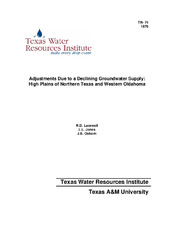| dc.description.abstract | The region north of the Canadian River in Texas and including the three western counties of Oklahoma have been rapidly developing the groundwater resource since the mid 1960's. This region, hereafter referred to as the Northern High Plains, is basically rural in nature with the principal agricultural products wheat, sorghum and cattle. Water is pumped from formations mainly for irrigating wheat and sorghum.
Since the Northern High Plains is a semi-arid region (average annual rainfall is about 21 inches), irrigation significantly increases crop yields. For wheat, irrigation increases yield from an expected 12 bushels per acre to 41 bushels per acre. Likewise, irrigated grain sorghum produces 5,300 pounds per acre compared to dryland production of 1,200 pounds per acre (Strickland and Harwell). Supplemental irrigation in agriculture results in a larger total use of agricultural inputs complementary with irrigation such as fertilizer, labor, chemicals for insect and weed control, steel, petroleum products and agricultural marketing facilities (Grubb). Larger total and individual farm incomes are a direct result of irrigation in the Northern High Plains which adds to the bundle of consumable agricultural products in the local, regional and national markets and in turn provides a demand for goods and services produced by non-agricultural sectors of the local, regional and national economies.
Water used for irrigation in the Northern High Plains is pumped from an aquifer, the Ogallala, with very little recharge; i.e., less than 1/2 inch per acre of surface area per year (Hughes and Harman). This means continued pumping will result in declining water levels and eventually economic exhaustion of the aquifer. As the water level decreases and the saturated thickness declines, pumping costs will increase and we]] yields will eventually decline. Beyond some peak or maximum number of irrigated acres the growth process will be reversed and irrigated acres will begin to decline.
Dependence of agricultural production on irrigation in the study area is emphasized by Osborn and Harris. It was estimated that the value of crop output in the Northern and Southern High Plains of Texas was $778.1 million in 1967. Of this total, $637.2 million was attributable to irrigated crops while dryland crops accounted for an output of $140.9 million. Total economic activity (direct and indirect) associated with the crop sectors was estimated to be $2.18 billion in 1967.
Agricultural output in the region can be expected to decline significantly as the transition from irrigated to dryland production occurs. Grubb has estimated that peak irrigated acreage in the Northern and Southern High Plains would occur in l980. Using 1959 data and irrigated acreage projections to the year 2020, the primary benefits from irrigation in the High Plains was estimated to be $20 per acre irrigated with indirect benefits of $35.31. It was concluded that the resulting decline in output from reduced irrigated acreage would have a serious impact on the regional economy.
Relating the effect of declining irrigation to the region, Osborn and Harris estimated the value of irrigated production to decline from $637 million in 1967 to $224 million in 2015, a decrease of 61.6 percent. Although it was estimated that the value of dryland production would increase 63.8 percent, the total value of crop production would be only 60.9 percent of the 1967 level. The total economic activity associated with crop sectors was estimated to decline from $2.18 billion in 1967 to $1.32 billion in 2015.
Another comprehensive study of the impact of a decline in groundwater was done by Hughes and Harman on a portion of the Southern High Plains. A 65 percent reduction in cotton production, a 91 percent reduction in sorghum production, and 22 percent increase in wheat production was estimated by the year 2015 as compared to 1966. This brought a decline in aggregate value of agricultural product from $432 million in 1966 to $128 million in 2015. These studies indicate a substantial reduction in agricultural income can be expected with reduced groundwater supplies.
Harman, Eidman, and Bekure have developed estimates of changes in aggregate agricultural output due to further development of irrigation and with a declining water supply for the Northern High Plains. Although these studies of expected adjustments to a declining water supply are complete for aggregate agricultural output, they do not extend to include expected adjustments within communities and impacts relative to individual producer profits, population and migration, public services and agriculturally related businesses.
In the developing stage, agricultural output increases resulting in associated increases in farm supplies and marketing facilities. This change provides an increasing tax base (based on the groundwater supply for irrigation) that can provide needed public services such as education, police and fire protection and other public services.
However, as the aquifer is dewatered, development may cease and cropland shift to dryland production. This results in a contraction of agricultural output and causes adjustments throughout the community and area that are related to the declining economic base of the area. The expected effect of reduced groundwater withdrawal on the regional economy and communities needs to be quantified with alternatives developed for slowing or reducing negative impacts. | en |


